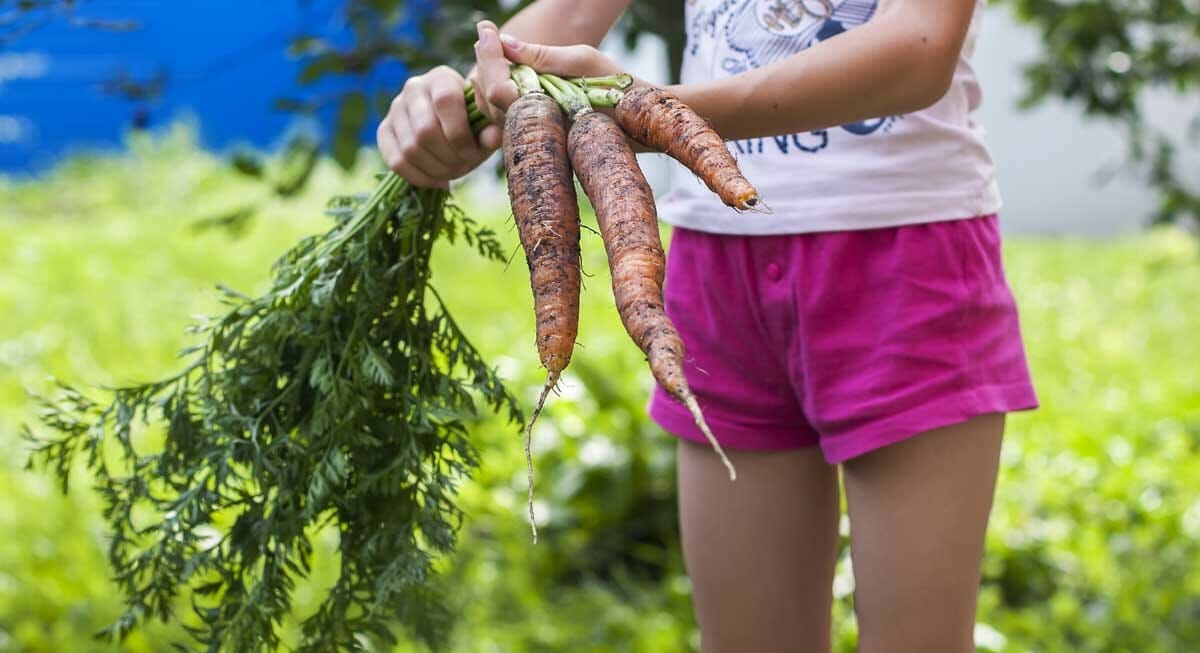Growing a cold-weather garden to maturity means getting started in mid- to late-summer.

Cool weather crops grow best when daytime temperatures are in the 70s and low 80s and nights are in the 40s and 50s. Once evening temperatures start to dip below freezing, most growth will stop, though you can continue to harvest most fall vegetables as long as evening temperatures don’t dip into the teens. The trick is to get them to a harvestable size in time – if you wait until the weather cools off to plant your seeds, it’ll likely be too late.
[mf_h2 align=”left” transform=”uppercase”]Count Backwards From Your Frost Date[/mf_h2]
Each region of the country has an ideal planting window for fall crops. They need time to mature while the weather is still warm, but if planted too early they may be stunted by the heat and many will bolt, meaning they will send up flower stalks and set seed prematurely, leaving the edible portion of the crop tough and bitter.
To find the optimal time to plant fall crops, you need to know the average date of first frost in your area. Your local cooperative extension office or any local nursery should be able to provide this information, or you can look it up in an online almanac. Then, check the back of the seed packet for each crop you want to plant for the “days to maturity.” Subtract that number from the average date of last frost to find the best time to plant.
For example, if you want to grow Calabrese broccoli, which needs about 75 days to mature, and your average date of first frost is October 15, plant the seeds no later than August 1. It’s better to err on the side of planting a bit early because growth will slow as the days get shorter, so the last two weeks of July is the optimal planting window in this scenario. Plus, you never know if cold weather will come earlier than usual.
[mf_list_sidebar layout=”basic” bordertop=”yes” title=”What to Plant” aftertitle=”Get inspired for your fall garden with the list of cool weather crops below. The approximate days to maturity are given for each crop.” separator=”no”]Lettuce – 50
Arugula – 40
Chard – 55
Spinach – 45
Kale – 60
Mustard – 40
Tatsoi – 45
Mizuna – 45
Broccoli – 80
Cauliflower – 75
Brussels sprouts – 90
Cabbage – 95
Beets – 60
Radishes – 30
Kohlrabi – 60
Turnips – 50
Rutabagas – 75
Carrots – 80
Onions* – 120
Garlic* – 120
*Onions and garlic are typically planted in early fall and harvested in late spring or early summer the following year[/mf_list_sidebar]
[mf_h2 align=”left” transform=”uppercase”]Sow Your Seeds[/mf_h2]
It’s easiest to start fall crops in flats rather than sow the seeds directly in the ground, so you can start them in a partially shaded area outdoors or in a sunny window indoors. The seedbed needs to remain evenly moist for germination to occur, which may require watering several times a day if temperatures are in the 90s. Alternatively, string up a canopy of shade cloth over a bed and start them directly where they are to grow.
[mf_h2 align=”left” transform=”uppercase”]Plant the Seedlings[/mf_h2]
Once your plants have two “true” leaves, which look more like the leaves on a mature plant, they’re ready to be planted. Although warm weather vegetables, like tomatoes, beans, squash and cucumbers, tend to be large, sprawling plants, most cool-weather crops are pint-sized in comparison, which makes them easy to plug into any available open space in the late summer garden. If any of your summer crops have succumbed to disease and are declining, pull them out and pop the fall crops in their place. You can even plug in fall seedlings around the base of taller summer crops that are still producing – they will benefit from the shade while the weather is still hot. Once the weather cools to the 70s or 80s during the day, however, cut the summer crops to the ground so the fall crops will flourish in full sun.
There is no need to till vegetable beds that have had summer crops growing in them before planting fall crops, but it helps to fork the soil lightly to loosen the top couple inches of soil, which may have become compacted over the course of the growing season. If you’re squeezing the seedlings in around existing summer plants, try to break up the crust on top of the soil at planting time and use a trowel to loosen the soil for each seedling to a depth of 4 or 5 inches – the larger plants shouldn’t mind the soil disturbance at this point in the season.
Assuming compost and soil amendments were mixed into the beds at planting time, there should be enough nutrients to support healthy growth of the fall crops. It never hurts to spread a fresh layer of compost on top of the soil when you plant them, however. Water the seedlings whenever the top inch of soil becomes dry to the touch. Fortunately, pests and disease are usually less of a problem once the weather cools.
[mf_h2 align=”left” transform=”uppercase”]The Fall Harvest[/mf_h2]
Cool weather brings out the best flavor in leafy greens and many root crops. Cauliflower, broccoli, cabbage, carrots and Brussels sprouts become extra sweet as the days become shorter. In the mild winter climates of California, Florida and the Deep South, fall crops may continue to produce all winter long. Wherever freezing weather is common, they will eventually succumb to the cold. In this case, you still have the option of installing row covers or cold frames over the crops to keep them alive and available for harvest well into early winter.
https://www.pinterest.com/pin/499547783659752907/
Very informative article. I got some good information for some questions I’ve had about fall gardening. By the way, I didn’t see Collards on the list. That’s a must for a Southern garden in my opinion. lol